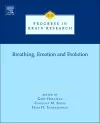
Breathing, Emotion and Evolution
3 contributors - Hardback
£199.00
Gert Holstege has published many of his most relevant papers in Progress in Brain Research. The first Progress in Brain Research paper appeared in 1982 in which he, together with Hans Kuypers showed the organization of the descending pathways from the brainstem to the spinal cord (Holstege and Kuypers, 1982),. In this paper he was the first to demonstrate which pathways controlled respiration by accessing motoneurons innervating the diaphragm, intercostal and abdominal muscles and the pelvic floor. In 1989 he published a paper explaining that the periaqueductal gray (PAG) produced vocalization by means of its projection to the nucleus retroambiguus, which, in turn, projects to respiration related motoneurons (Holstege, 1989). This system also produces sound production in humans. In a Progress in Brain Research paper of 1991 Holstege, for the first time, showed that respiration is similarly organized as other specific control systems as blood pressure, heart frequency, micturition and mating control systems (Holstege, 1991). In a Progress in Brain Research Volume chapter in 1996, Holstege, together with Bandler and Saper brought all these motor systems together with their midbrain and higher level control systems in the concept of the Emotional Motor System (Holstege et al., 1996). Studies using PET-scanning demonstrated that the micturition control system in humans was almost identical to that in cats (Blok et al., 1997). It explained also the reason why so many elderly suffer from overactive bladder and urge-incontinence. This problem, one of the most costly in healthcare in general, is caused by the many small infarctions in the white matter of the prefrontal cortex interrupting the connections between the medial orbitofrontal cortex and the PAG as the central micturition control system. Since in the cat also the hardware of sexual behavior has been detected, Holstege and co-workers also investigated the brain function during sexual activities in humans, which revealed that the same centers in the pontine reticular formation controlled ejaculation and female orgasm, again similar to the cat control systems (Huynh et al., 2013). In simple terms the brainstem runs all the basic motor systems via specific projections to the motoneurons in the spinal cord that execute the motor act, not only respiration, but also heart rate, blood pressure, micturition, defecation, and sexual activities. In all likelihood, parturition in women will also be under control of these systems (Holstege, 2014). Blok, B. F., Willemsen, A. T. and Holstege, G. (1997). A pet study on brain control of micturition in humans. Brain 120 ( Pt 1), 111-121. Holstege, G. (1989). Anatomical study of the final common pathway for vocalization in the cat. J Comp Neurol 284, 242-252. Holstege, G. (1991). Descending motor pathways and the spinal motor system: Limbic and non-limbic components. Prog Brain Res 87, 307-421. Holstege, G. (2014). The periaqueductal gray controls brainstem emotional motor systems including respiration. Progress in Brain Research in press. Holstege, G. and Kuypers, H. G. (1982). The anatomy of brain stem pathways to the spinal cord in cat. A labeled amino acid tracing study. Prog Brain Res 57, 145-175. Holstege, G., Bandler, R. and Saper, C. B. (1996). The emotional motor system. Prog Brain Res 107, 3-6. Huynh, H. K., Willemsen, A., Lovick, T. A. and Holstege, G. (2013). Pontine control of ejaculation and female orgasm. J. Sex. Med. in press. Dr. Subramanian holds a PhD in systems neuroscience and holds a Senior Research Fellowship at the University of Queensland Centre for Clinical Research (UQCCR), Asia-Pacific Centre for Neuromodulation (APCN); he is also an affiliate at the Queensland Brain Institute (QBI), a teaching intern at the School of Biomedical Sciences, and an honorary senior research associate at the University of Sydney. His research focuses on the systems neurophysiology of autonomic control and treatment of neurogenic autonomic disorders via neuromodulation of brainstem circuits and his discoveries have been critical for establishing the periaqueductal gray as the “emotional controller of the autonomic nervous system. He is editor of two volumes of the series Progress in Brain Research and the author of more than fifty articles and papers.